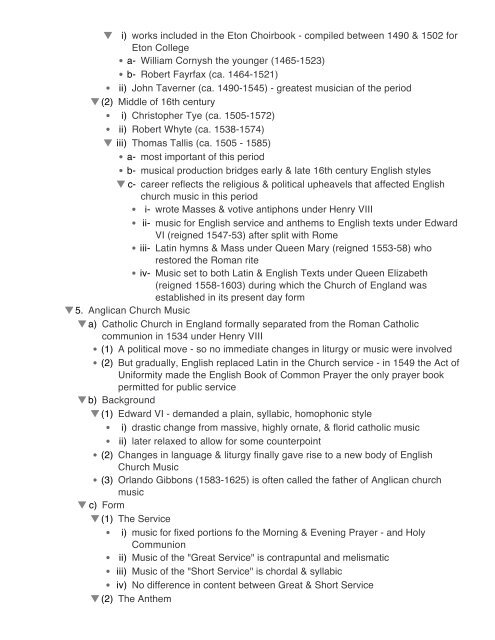An Outline of The History of Western Music Grout ... - The Reel Score
An Outline of The History of Western Music Grout ... - The Reel Score
An Outline of The History of Western Music Grout ... - The Reel Score
You also want an ePaper? Increase the reach of your titles
YUMPU automatically turns print PDFs into web optimized ePapers that Google loves.
i) works included in the Eton Choirbook - compiled between 1490 & 1502 for<br />
Eton College<br />
a- William Cornysh the younger (1465-1523)<br />
b- Robert Fayrfax (ca. 1464-1521)<br />
ii) John Taverner (ca. 1490-1545) - greatest musician <strong>of</strong> the period<br />
(2) Middle <strong>of</strong> 16th century<br />
i) Christopher Tye (ca. 1505-1572)<br />
ii) Robert Whyte (ca. 1538-1574)<br />
iii) Thomas Tallis (ca. 1505 - 1585)<br />
a- most important <strong>of</strong> this period<br />
b- musical production bridges early & late 16th century English styles<br />
c- career reflects the religious & political upheavels that affected English<br />
church music in this period<br />
i- wrote Masses & votive antiphons under Henry VIII<br />
ii- music for English service and anthems to English texts under Edward<br />
VI (reigned 1547-53) after split with Rome<br />
iii- Latin hymns & Mass under Queen Mary (reigned 1553-58) who<br />
restored the Roman rite<br />
iv- <strong>Music</strong> set to both Latin & English Texts under Queen Elizabeth<br />
(reigned 1558-1603) during which the Church <strong>of</strong> England was<br />
established in its present day form<br />
5. <strong>An</strong>glican Church <strong>Music</strong><br />
a) Catholic Church in England formally separated from the Roman Catholic<br />
communion in 1534 under Henry VIII<br />
(1) A political move - so no immediate changes in liturgy or music were involved<br />
(2) But gradually, English replaced Latin in the Church service - in 1549 the Act <strong>of</strong><br />
Uniformity made the English Book <strong>of</strong> Common Prayer the only prayer book<br />
permitted for public service<br />
b) Background<br />
(1) Edward VI - demanded a plain, syllabic, homophonic style<br />
i) drastic change from massive, highly ornate, & florid catholic music<br />
ii) later relaxed to allow for some counterpoint<br />
(2) Changes in language & liturgy finally gave rise to a new body <strong>of</strong> English<br />
Church <strong>Music</strong><br />
(3) Orlando Gibbons (1583-1625) is <strong>of</strong>ten called the father <strong>of</strong> <strong>An</strong>glican church<br />
music<br />
c) Form<br />
(1) <strong>The</strong> Service<br />
i) music for fixed portions fo the Morning & Evening Prayer - and Holy<br />
Communion<br />
ii) <strong>Music</strong> <strong>of</strong> the "Great Service" is contrapuntal and melismatic<br />
iii) <strong>Music</strong> <strong>of</strong> the "Short Service" is chordal & syllabic<br />
iv) No difference in content between Great & Short Service<br />
(2) <strong>The</strong> <strong>An</strong>them





